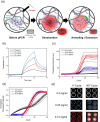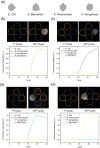Ultrafast Real-Time PCR in Photothermal Microparticles
- PMID: 36475304
- PMCID: PMC9799066
- DOI: 10.1021/acsnano.2c07017
Ultrafast Real-Time PCR in Photothermal Microparticles
Abstract
As the turnaround time of diagnosis becomes important, there is an increasing demand for rapid, point-of-care testing (POCT) based on polymerase chain reaction (PCR), the most reliable diagnostic tool. Although optical components in real-time PCR (qPCR) have quickly become compact and economical, conventional PCR instruments still require bulky thermal systems, making it difficult to meet emerging needs. Photonic PCR, which utilizes photothermal nanomaterials as heating elements, is a promising platform for POCT as it reduces power consumption and process time. Here, we develop a photonic qPCR platform using hydrogel microparticles. Microparticles consisting of hydrogel matrixes containing photothermal nanomaterials and primers are dubbed photothermal primer-immobilized networks (pPINs). Reduced graphene oxide is selected as the most suitable photothermal nanomaterial to generate heat in pPIN due to its superior light-to-heat conversion efficiency. The photothermal reaction volume of 100 nL (predefined by the pPIN dimensions) provides fast heating and cooling rates of 22.0 ± 3.0 and 23.5 ± 2.6 °C s-1, respectively, enabling ultrafast qPCR within 5 min only with optical components. The microparticle-based photonic qPCR facilitates multiplex assays by loading multiple encoded pPIN microparticles in a single reaction. As a proof of concept, four-plex pPIN qPCR for bacterial discrimination are successfully demonstrated.
Keywords: bacteria; hydrogel; multiplex assay; photonic PCR; real-time PCR; reduced graphene oxide (rGO).
Conflict of interest statement
The authors declare no competing financial interest.
Figures







References
-
- Qiu X.; Yuan J.. Temperature control for PCR thermocyclers based on Peltier-effect thermoelectric. 2005 IEEE Engineering in Medicine and Biology 27th Annual Conference, 2006; IEEE: pp 7509–7512. - PubMed
-
- Son J. H.; Cho B.; Hong S.; Lee S. H.; Hoxha O.; Haack A. J.; Lee L. P. Ultrafast photonic PCR. Light: Science & Applications 2015, 4 (7), e280–e280. 10.1038/lsa.2015.53. - DOI
Publication types
MeSH terms
Substances
LinkOut - more resources
Full Text Sources
Other Literature Sources
Research Materials

